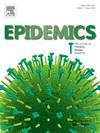根据早期监测结果,为 Omicron SARS-CoV-2 变体建立模型。
IF 2.4
3区 医学
Q2 INFECTIOUS DISEASES
引用次数: 0
摘要
我们使用了基于空间明确代理的 SARS-CoV-2 传播模型,并结合苏格兰公共卫生部门提供的空间精细 COVID-19 观察数据,研究了令人担忧的 Omicron (BA.1) 变种的最初兴起。我们根据当时可获得的数据,评估了相对于德尔塔变异体的传播率优势和疫苗免疫逃逸的可能情况。我们还探讨了不同程度的强制非药物干预可能产生的结果。在奥米克隆变种疫情爆发的早期阶段,苏格兰政府参考了这些方案的初步结果。利用模型参数拟合三角洲变种疫情、一些关于奥米克隆传播率优势和疫苗逃逸的初始假设以及一个简单的增长率拟合程序,我们能够捕捉到奥米克隆的初始疫情动态。我们发现,模拟的疫情动态经得起回顾性检验。鉴于奥米克隆变体所具有的传播率优势,以及计划中的干预措施在疫情发展过程中出现得太晚,苏格兰政府当时计划采取的额外非药物干预措施可能效果甚微。最后,我们发现,就疫情规模和爆发时间而言,对模型人群中疫苗的预期分布所做的任何假设对结果的影响都很小。相反,最重要的是先前的免疫状况。本文章由计算机程序翻译,如有差异,请以英文原文为准。
Modelling plausible scenarios for the Omicron SARS-CoV-2 variant from early-stage surveillance
We used a spatially explicit agent-based model of SARS-CoV-2 transmission combined with spatially fine-grained COVID-19 observation data from Public Health Scotland to investigate the initial rise of the Omicron (BA.1) variant of concern. We evaluated plausible scenarios for transmission rate advantage and vaccine immune escape relative to the Delta variant based on the data that would have been available at that time. We also explored possible outcomes of different levels of imposed non-pharmaceutical intervention. The initial results of these scenarios were used to inform the Scottish Government in the early outbreak stages of the Omicron variant.
Using the model with parameters fit over the Delta variant epidemic, some initial assumptions about Omicron transmission rate advantage and vaccine escape, and a simple growth rate fitting procedure, we were able to capture the initial outbreak dynamics for Omicron. We found that the modelled dynamics hold up to retrospective scrutiny. The modelled imposition of extra non-pharmaceutical interventions planned by the Scottish Government at the time would likely have little effect in light of the transmission rate advantage held by the Omicron variant and the fact that the planned interventions would have occurred too late in the outbreak’s trajectory. Finally, we found that any assumptions made about the projected distribution of vaccines in the model population had little bearing on the outcome, in terms of outbreak size and timing. Instead, it was the landscape of prior immunity that was most important.
求助全文
通过发布文献求助,成功后即可免费获取论文全文。
去求助
来源期刊

Epidemics
INFECTIOUS DISEASES-
CiteScore
6.00
自引率
7.90%
发文量
92
审稿时长
140 days
期刊介绍:
Epidemics publishes papers on infectious disease dynamics in the broadest sense. Its scope covers both within-host dynamics of infectious agents and dynamics at the population level, particularly the interaction between the two. Areas of emphasis include: spread, transmission, persistence, implications and population dynamics of infectious diseases; population and public health as well as policy aspects of control and prevention; dynamics at the individual level; interaction with the environment, ecology and evolution of infectious diseases, as well as population genetics of infectious agents.
 求助内容:
求助内容: 应助结果提醒方式:
应助结果提醒方式:


